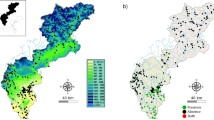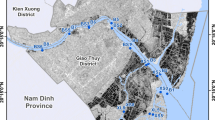Abstract
Neural networks and multiple linear regression models of the abundance of brown trout (Salmo trutta L.) on the mesohabitat scale were developed from combinations of physical habitat variables in 220 channel morphodynamic units (pools, riffles, runs, etc.) of 11 different streams in the central Pyrenean mountains. For all the 220 morphodynamic units, the determination coefficients obtained between the estimated and observed values of density or biomass were significantly higher for the neural network (r 2 adjusted= 0.93 and r 2 adjusted=0.92 (p<0.01) for biomass and density respectively with the neural network, against r 2 adjusted=0.69 (p<0.01) and r 2 adjusted = 0.54 (p<0.01) with multiple linear regression). Validation of the multivariate models and learning of the neural network developed from 165 randomly chosen channel morphodynamic units, was tested on the 55 other channel morphodynamic units. This showed that the biomass and density estimated by both methods were significantly related to the observed biomass and density. Determination coefficients were significantly higher for the neural network (r 2 adjusted =0.72 (p<0.01) and 0.81 (p<0.01) for biomass and density respectively) than for the multiple regression model (r 2 adjusted=0.59 and r 2 adjusted=0.37 for biomass and density respectively). The present study shows the advantages of the backpropagation procedure with neural networks over multiple linear regression analysis, at least in the field of stochastic salmonid ecology.
Similar content being viewed by others
References
Albiol, J., C. Campmajo & M. Poch, 1995. Biomass estimation in plant cell cultures: a neural network approach. Biotechnol. Prog. 11: 88–92.
Baran, P., F Dauba, M. Delacoste & J. M. Lascaux, 1993a. Essais d'évaluation quantitative du potentiel halieutique d'une rivière à Salmonidés à partir des données de l'habitat physique. In D. Gascuel, P. Durand & M. Fonteneau, Les recherches françaises en evaluation quantitatives et modélisation des ressources et systèmes halieutiques, Editions de l'ORSTOM, Colloque et Séminaire, Paris: 15–38.
Baran, P., M. Delacoste, J. M. Lascaux & A. Belaud, 1993b. Relations entre les caracteristiques de l'habitat et les populations de truites communes (Salmo trutta L.) de la vallée de la Neste d'Aure. Bull. Fr. Peche Piscic. 331: 321–340.
Baran, P., M. Delacoste, G. Poizat, J. M. Lascaux, S. Lek & A. Belaud, 1995. Approche multi-échelles des relations entre les caractéristiques d'habitat et les populations de truite commune (Salmo trutta L.) dans les Pyrénées centrales. Bull. Fr. Peche Piscic. 337: 399–406.
Binns, N. A. & F. M. Eiserman, 1979. Quantification of fluvial trout habitat in Wyoming. Trans. am. Fish. Soc. 108: 215–228.
Bovee, K. D.,1982. A guide to stream habitat analysis using instream flow incremental methodology. Instream Flow Information Paper n° 12, FWS/OBS 82/86, 248 pp.
Cai, Y., 1995. Artificial neural network method for soil erosion forecasting. J. landwirtsch. Forsch. 46: 19–24.
Carpenter, G. A., 1989. Neural network models for pattern recognition and associative memory. Neural Networks 2: 243–257.
Chen, S., S. A. Billings & P. M. Grant, 1990. Non-linear system identification using neural networks. Int. J. Control 51: 1191–1214.
Clark, R. D., G. R. Alexander & H. Gowing, 1980. Mathematical description of trout-stream fisheries. Trans. am. Fish. Soc. 109: 587–601.
Colasanti, R. L., 1991. Discussions of the possible use of neural network algorithms in ecological modelling. Binary 3: 13–15.
D'Angelo, D. J., L. M. Howard, J. L. Meyer, S. V. Gregory & L. R. Ashkenas, 1995. Ecological uses for genetic algorithms: predicting fish distributions in complex physical habitats. Can. J. Fish. aquat. Sci 52: 1893–1908.
De Lury D. B., 1951. On the planning of experiments for the estimation of fish populations. J. Fish. Res. Bd Can. 18: 281–307.
Delacoste, M., P. Baran, J. M. Lascaux & S. Lek, 1995. Classification et clé de détermination des faciès d'écoulement en rivière de montagne. Bull. Fr. Peche Piscic. 337: 149–156.
Dimopoulos, I., S. Lek & J. Lauga, 1996. Modélisation de la relation pluie-débit par les réseaux connexionnistes et le filtre de Kalman. Hydrol. Scis J. 41: 179–193.
Edwards, M. & D. R. Morse, 1995. The potential for computer-aided identification in biodiversity research. TREE 10: 153–158.
Fausch, K. D., C. L. Hawkes & M. G. Parsons, 1988. Models that predict the standing crop of stream fish from habitat variables. U.S. Forest Service General Technical Report PNW-GTR. 213 pp.
Haury, J., D. Ombredane & J. L. Bagliniere, 1991. L'habitat de la truite commune (Salmo trutta L.) en eaux courantes. In J. L. Baglinière & G. Maisse, La truite, biologie et écologie. INRA Publ., Paris: 25–46.
Heggenes, J., 1988. Physical habitat selection by brown trout (Salmo trutta) in riverine systems. Nordic. J. Freshwat. 64: 74–90.
Hornik, K., M. Stinchcombe & H. White, 1989. Multilayer feedforward networks are universal approximators. Neural Networks 2: 359–366.
Jowett, I. G., 1992. Models of the abundance of large brown trout in New Zealand rivers. North Am. J. Fish. Mgmt 12: 417–432.
Jowett, I. G., 1993. A method for objectively identifying pool, run, and riffle habitats from physical measurements. New Zealand J. Mar. Freshwat. Res. 27: 241–248.
Laurent, M. & P. Lamarque, 1975. Utilisation de la méthode des captures successives (De Lury) pour l'évaluation des peuplements piscicoles. Bull. Fr. Pêche Piscic. 259: 66–67.
Lek, S., A. Belaud, I. Dimopoulos, J. Lauga & J. Moreau, 1995. Improved estimation, using neural networks, of the food consumption of fish populations. Aust. J. Mar. Freshwater Res. 46: 1229–1236.
Lek, S., M. Delacoste, P. Baran, I. Dimopoulos, J. Lauga & S. Aulagnier, 1996. Application of neural networks to modelling non-linear relationships in ecology. Ecol. Model 90: 39–52.
Lewis, S. L., 1969. Physical factors influencing fish populations in pool of a trout stream. Trans. am. Fish. Soc. 115: 183–195.
Malavoi, J. R., 1989. Typologie des faciès d'écoulement ou unités morpho-dynamiques d'un cours d'eau à haute énergie. Bull. Fr. Peche Piscic. 315: 189–210.
Nehring, R. B. & R. M. Anderson, 1993. Determination of population-limiting critical salmonid habitats in colorado streams using physical habitat simulation system. Rivers 4: 1–19.
Newcombe, C. P., 1981. A procedure to estimate changes in fish populations caused by changes in stream discharge. Trans. am. Fish. Soc. 110: 382–390.
Orth, D. J., 1987. Ecological considerations in the development and application of instream flow-habitat models. Regulated Rivers: Research & Management. 1: 171–181.
Platts, W. S. & R. L. Nelson, 1988. Fluctuations in trout populations and their implications for land-use evaluation. North. am. J. Fish. Mgmt 8: 333–345.
Raman, H. & N. Sunilkumar, 1995. Multivariate modelling of water resources time series using artificial neural networks. Hydrol. Scis J. 40: 145–163.
Rumelhart, D. E., G. E. Hinton & R. J. Williams, 1986. Learning representations by back-propagating error. Nature 323: 533–536.
Seginer, I., T. Boulard & B. J. Bailey, 1994. Neural network models of the greenhouse climate. J. agric. Engineer. Res. 59: 203–216.
Specht, D. F., 1991. A general regression neural network. IEEE Trans. on Neural Networks 2: 568–576.
Ter braak, C. J. F., 1986. Canonical correspondence analysis: a new eigenvector technique for multivariate direct gradient analysis. Ecology 67: 1167–1179.
Tomassone, R., E. Lesquoy & C. Millier, 1983. La régression, nouveaux regards sur une ancienne méthode statistique. INRA actualités scientifiques et agnomiques, 13, Masson, Paris: 177 pp.
Weigend, A. S., B. A. Huberman & D. E. Rumelhart, 1992. Predicting sunspots and exchange rates with connectionist networks. In Nonlineal Modelling and Forecasting, SFI Studies in the Sciences of Complexity, Proc. vol XII (eds) M. Casdagli & S. Eubank, Addison-Wesley: 395–432.
Weisberg, S., 1980. Applied linear regression. John Wiley & Sons, New York: 324 pp.
Author information
Authors and Affiliations
Rights and permissions
About this article
Cite this article
Baran, P., Lek, S., Delacoste, M. et al. Stochastic models that predict trout population density or biomass on a mesohabitat scale. Hydrobiologia 337, 1–9 (1996). https://doi.org/10.1007/BF00028502
Received:
Revised:
Accepted:
Published:
Issue Date:
DOI: https://doi.org/10.1007/BF00028502




